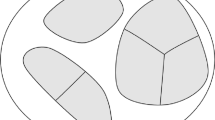Abstract
In this paper, an intelligent heuristic optimization algorithm in active variation compensation is proposed to improve the dimension accuracy in the assembly of a vehicle body by finding the optimal configuration of joint types and the corresponding assembly sequence to compensate variation accumulation in the conceptual assembly process. The authors develop and apply the algorithm to predict variation accumulation and then develop compensating assembly schemes to accomplish optimal joint configuration and assembly sequence compensating for the unnecessary or surplus variation. The essence of the active variation compensation algorithm means measuring and correcting assembling variations during the assembly conceptual process. The paper employs the design of experiment (DOE) approach to verify the heuristic optimization method in the simple application case.
Similar content being viewed by others
References
Feng SC, Song EY (2000) Information modeling of conceptual process planning integrated with conceptual design. Proceedings of DETC2000. The 2000 ASME Design Engineering Technical Conferences, September 10–13, Baltimore, Maryland
Chen Y, Feng PE, Lin ZQ (2005) A genetics-based approach for the principle conceptual design of mechanical products. Int J Adv Manuf Technol 27:225–233
Hsu W, Lim A, Lee CSG (1996) Conceptual level design for assembly analysis using state transitional approach. Proc IEEE Int Conf Robot Autom 4:3355–3361
Lombeyda SV, Regli WC (1999) Conceptual design for assembly. Proceedings of the 1999 ASME design engineering technical conferences, September 12–15, Las Vegas, Nevada
Gottipolu RB, Ghosh K (1997) Representation and selection of assembly sequences in computer-aided assembly process planning. Int J Prod Res 35(12):3447–3465
Thornton AC (1999) A mathematical framework for the key characteristics process. Res Eng Des 11:145–157
Chirdchid S, Mazouz AK (2002) A genetic algorithm for combined parameter and tolerance design optimization. IEEE ICIT, 2002, Bangkok, Thailand, pp 1223–1228
Liu SC, Hu SJ (1998) Sheet metal joint configurations and their variation characteristics. J Manuf Sci Eng 120(5):461–467
Liu SC, Hu SJ (1997) A parametric study of joint performance in sheet metal assembly. Int J Mach Tools Manuf 37(6):873–884
Ceglarek D, Shi J (1998) Deign evaluation of sheet metal joints for dimension integrity. J Manuf Sci Eng 120:452–460
Nikolaidis E, Long LH, Ling Q (2000) Neural networks and response surface polynomials for design of vehicle joints. Comput Struct 75:593–607
Lee B, Saitou K (2003) Assembly synthesis with subassembly partitioning for optimal in-process dimensional adjustability. Proceedings of the ASME design engineering technical conference 2 A:257–268
Chase KW, Parkinson AR (1991) A survey of research in the application of tolerance analysis to the design of mechanical assemblies. Res Eng Des 3:23–37
Chase KW, Gao J, Magleby SP (1995) General 2-D tolerance analysis of mechanical assemblies with small kinematic adjustments. J Des Manuf 5:263–274
Gao J, Chase KW, Magleby SP (1998) Generalized 3-D tolerance analysis of mechanical assemblies with small kinematic adjustments. IIE Trans 30:367–377
Roy U, Li B (1998) Representation and interpretation of geometric tolerances for polyhedral objects-1. Form tolerances. Comput Aided Des 30(2):151–161
Roy U, Li B (1999) Representation and interpretation of geometric tolerances for polyhedral objects-II. Size, orientation and position tolerances. Comput Aided Des 31:273–285
Zhang G (1996) Simultaneous tolerancing for design and manufacturing. Int J Prod Res 34:3361–3382
Salomons OW, Poerink HJJ, Slooten FV, Van Houten FJAM, Kals HJJ (1995) A computer-aided tolerancing tool based on kinematic analogies. CIRP/JSPE/ASME Proceedings of the 4th CIRP seminar on computer aided tolerancing. The University of Tokyo, Tokyo, Japan, April 5–6, pp 53–72
Shiu BW, Apley DW, Ceglarek D, Shi J (2003) Tolerance allocation for compliant beam structure assemblies. IEE Trans 35:329–342
Ciarallo FW, Yang CC (1997) Optimization of propagation in interval constraint networks for tolerance design. IEEE 1924–1929
Yang CC, Marefat MM, Ciarallo FW (1997) Tolerance analysis and synthesis by interval constraint networks. IEEE 2522–2527
Ceglarek DJ (1998) Multivariate analysis and evaluation of adaptive sheet metal assembly system. Ann CIRP 47(1):17–22
Johannessson H, Soderberg R (2000) Structure and matrix models for tolerance analysis from configuration to detail stage. Res Eng Des 12:112–125
Xiong C, Rong Y, Koganti RP, Zaluzec MJ, Wang N (2002) Geometric variation prediction in automotive assembling. Assem Autom 22(3):260–269
Cai W, Long YF, Hsieh C (2003) Variation simulation for digital panel assembly. ASME International Mechanical Engineering Congress, Washington, DC, Nov 12–15
Huang Q, Zhou NR, Shi JJ (2000) Stream of variation modeling and diagnosis of multi-station machining processes. Proceeding of IMECE 2000. International mechanical engineering congress & exposition, Nov 5–10, 2000, Orlando, Florida
Ceglarek D, Huang W, Zhou S, Ding Y, Kumar R, Zhou Y (2004) Time-based competition in multistage manufacturing: Stream-of-variation Analysis (SOVA) methodology-review. Int J Flex Manuf Syst 16:11–44
Gerth RJ, Pfeifer T, Oehme O (2000) Early cost tolerance sensitivity analysis for inspection planning. Human Factors Ergon Manuf 10(3):309–329
Gao JS, Chase KW, Magleby SP (1998) Global coordinate method for determining sensitivity in assembly tolerance analysis. Proceedings of the ASME international mechanical engineering conference and exposition, Anaheim, California
Author information
Authors and Affiliations
Corresponding author
Rights and permissions
About this article
Cite this article
Yubing, L., Guanlong, C., Cheng, Z. et al. Active variation compensation in vehicle body conceptual assembly. Int J Adv Manuf Technol 37, 178–190 (2008). https://doi.org/10.1007/s00170-007-0961-8
Received:
Accepted:
Published:
Issue Date:
DOI: https://doi.org/10.1007/s00170-007-0961-8




